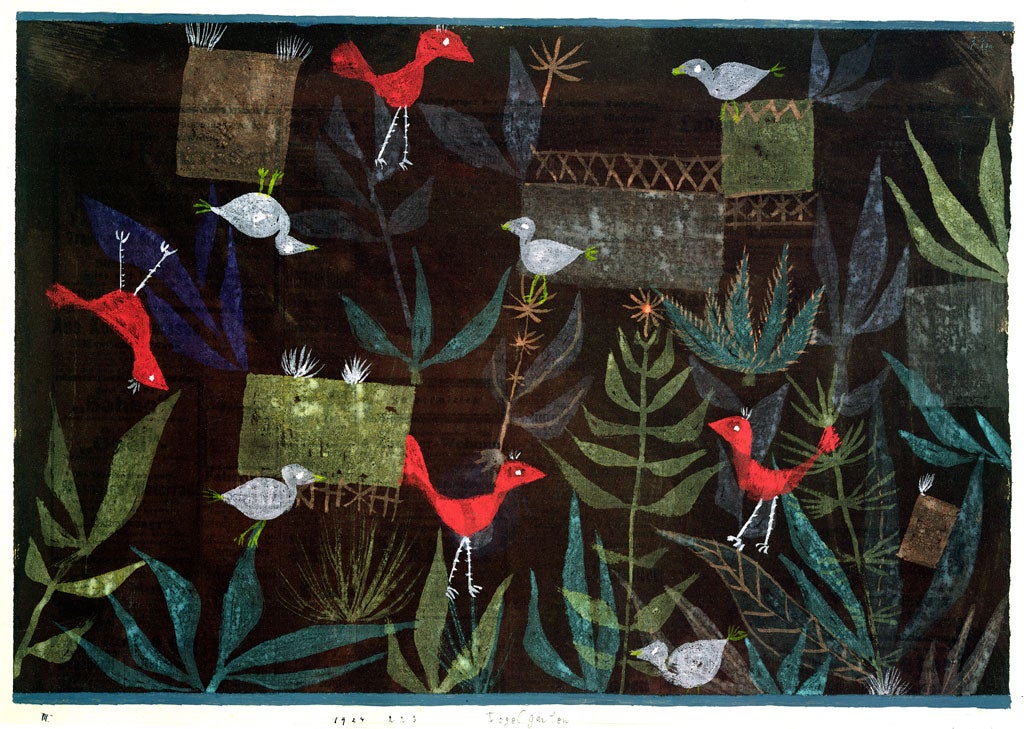Great Works: Bird Garden, 1924 (27cm x 39 cm), Paul Klee
Pinakothek der Moderne, Munich

There is something utterly self-sufficient about much of the world of Paul Klee. Once inside it, and having shut the door on the hubbub of misery and awkwardness just beyond its tiny perimeters (you would be hard pushed to find a large work by Klee), you feel perfectly at ease in its company.
It offers us a kind of lightsome alternative, perpetually self-delighting and delighting us too. It does not feel solipsistic in the least. It is tangentially related to the world in which we all live, move and have our being, but it is also utterly set apart from it. Living in parallel, you might say. In part, it is a world of childish guilelessness, but then again it is not, because we also sense how immensely calculated it all is.
Klee was no untutored boy. He worked for years as a professor at the Bauhaus. In fact, it would be true to say that Klee was a gaunt, serious and besuited grown child – we see that from many of the photographs of him, and the discovery rather surprises us. Klee has thought long and hard about botany, the laws of gravity and other serious matters and then, quite deliberately, he has set them aside to do something quite different – or to do something as a kind of alternative commentary to the rules of things as we imagine them. He has, gently, set aside the world as we see it.
This lovely, fantastic, absurdly comic garden scene is as much music as painting. We feel that on our pulses as we look at it. Its lovely incongruities provoke delight. Each of those brash, small birds, so perkily self-assured, sounds like a single brazen struck note, usually quite a high note because they are treading very delicately upon the tops of all the leaves and all the plants.
Not one of them is making any impression upon these plants, many of which are quite gorgeously sculpted, or on these leaves either. They are too light and too weightless to do any damage. In fact, they are so thin and light and dancingly papery-airy, so close to a kind of blow-away nothingness, that if we look carefully, we can see right through them to the newsprint on top of which they have been magically painted into being.
Not one of them is flying. They have no such ambitions. They are perfectly, harmoniously at rest, picking their way back and forth, round and round, across the tops of equally fragile and delicate natural things. Nothing bends beneath their relative weightlessness. They walk on longish legs which look like thin sticks of carefully buntinged and tagged Blackpool rock. They are walkers or standers to a man (or a girl).
In its totality, the music of this piece resembles that of a musical box, with the pleasing circularity of that clever, always beguiling device, the way the tune insists upon going round and round and round until you almost fall asleep, spell-bound, as you listen. This picture too, though it is rectangular in shape and, though small, a little larger than we really expect to be (it has the look of a miniature), feels as if it is endlessly circling.
Yes, the picture is in motion – comic motion, of a kind – but it is also utterly frozen. It looks like a little like a frieze, never to be changed or disturbed in its delicately attuned artfulness. Tonally, it is very strange. Its murky, earthy greens make it feel almost aquatic. There is more than a hint of swimming here, and the kind of swivelly, darty movements that we expect of fish. It promises to be deep to look into – we want to look in, quite far – but our wishes are thwarted. The garden itself is, of course, pure artifice. It is a kind of prototypical paradisal scene.
There is man-made intervention here too, architectural details of a rather lovely kind, bits of lattice-work across the top (or along the bottom) of fragments of floating, wall-like structure – yes, even the illusion of a wall is robbed of its yearning towards solidity. These walls are slightly on the tilt, as if dreamily nodding off. The shapes of the leaves are leaf-shaped, but also not quite so. They are leaves which have been crisply scissored into form, quite extravagantly beautifully. They, like the birds, are permeable. When they overlap, we can often look through them.
This world of Klee's has removed all the tetherings, and we feel ourselves floating with it. The fact that two of these birds are walking upside down makes us feel that at any moment this painting could spin away from us, at first rather slowly. And when that happens, we will surely feel ourselves rather inclined to take flight too. Thank you for the invitation, Mr Klee.
ABOUT THE ARTIST
Paul Klee (1879-40) was born near Berne in Switzerland. His glowing and translucent watercolours, often resembling jewel-like miniatures, bear us away into alternative elsewheres. In spite of the naivety of his vision, his art is always underpinned by rigorous theoretical questioning.
Subscribe to Independent Premium to bookmark this article
Want to bookmark your favourite articles and stories to read or reference later? Start your Independent Premium subscription today.

Join our commenting forum
Join thought-provoking conversations, follow other Independent readers and see their replies